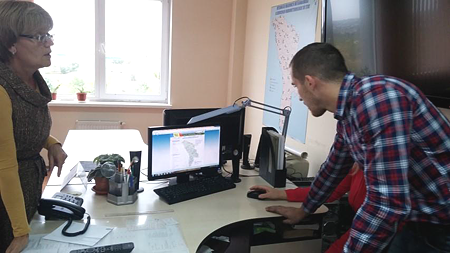|
Meteorology
Department
|
|
|
|
|
|
Meteorological Forecast Centre




Data used in the
forecasting process
In order to develop
a forecast, the Meteorological Forecast Centre analyzes non-stop
a huge amount of aerosynoptic data, including:
-
Data on weather
elements (air and soil temperature, air humidity, wind direction
and velocity, atmospheric pressure and baric trend, cloud cover
ant types, precipitations and atmospheric phenomena), collected
within the national observations network, as well as the data
recorded at the ground weather stations located in Europe, as
well as the maritime stations across the Northern Atlantic;
-
Information about
the state of the atmosphere in the air layer up to 20 km
altitude (air temperature and humidity, wind direction and
velocity on the standard isobaric surfaces) recorded at the
upper air ground and maritime stations, located in Europe and
across the northern Atlantic;
-
METEOSAT and
NOAA images of
the clouds;
-
Radar
information, recorded in Moldova (the meteorological radar MRL-5
located at the Chişinău International Airport) and in Romania
(composite image of the Doppler radar, National Meteorological
Administration of Romania);
-
Synoptic
charts developed on the basis of numeric models of the main
global forecasting centers –
DWD (Deutscher
Wetterdienst,
Germany),
ECMWF (European
Centre for Medium-Range Weather Forecasts,
UK),
MetOffice (National
Weather Service,
UK),
GFS
(NCEP,
SUA),
NOGAPS (Fleet
Numerical Meteorology and Oceanography Center,
Canada),
ALADIN/ARPÅGE (Meteo-France),
JMA (Japan
Meteorological Agency),
MSC
(Meteorological Service of Canada),
USAFE and
MM5
(Air
Force Weather Agency,
USA).
The information is
received as charts and telegrams encoded by using the
international meteorological codes.
The direct
data channel Chişinău-Moscova is operating in the frame of the
Centre. It is used to exchange the information and to display
the
GIS-Meteo
meteorological information.
Also, in
November 2010, within the regional
EUMETSAT
project, the DAWBEE station of reception and visualisation of
satellite data was installed in the National Meteorological
Forecasting Center, through which it is realized the monitoring
in cvasi-real time of the atmospherical status, evolution of
cloud systems, humidity fields characteristics and
meteorological phenomena etc.
|

